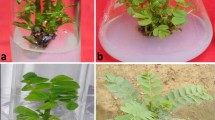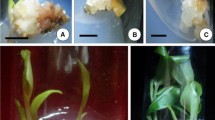Abstract
Robinia ambigua var. idahoensis, presumably originated from interspecific hybridization of R. pseudoacacia L. and R. hispida L., is a multipurpose tree. Several reports have showed that in vitro micropropagation is a feasible method to produce large quantities of ‘clonal’ plants from R. pseudoacacia, however, no information is available on micropropagation of R. ambigua or the other assumed parental species, R. hispida. Here, we report on a tissue culture system for efficient micropropagation of R. ambigua plants by enhanced branching of axillary buds taken from a single branch of a donor tree. The culture system consists of sequential use of three media, namely, the bud-induction medium (MS medium supplemented with 0.8–1.4 mg l−1 6-BA, 0.05–0.08 mg l−1 NAA and 0.07–0.1 mg l−1 GA), elongation medium (MS medium added with 0.35–0.5 mg l−1 6-BA, 0.05–0.08 mg l−1 NAA and 0.07–0.1 mg l−1 GA) and root-induction medium (1/4 MS medium fortified with 1.7–2.5 mg l−1 IAA and 0.1–0.5 mg l−1 IBA). In addition, we investigated the genetic stability (relative to the donor plant) of a sample of 41 morphologically normal plants randomly taken from ca. 13,000 micropropagated plants, by using the inter-simple sequence repeat (ISSR) marker with 32 selected primers. We found that of the 226 reproducible bands scored, 24 were polymorphic (10.62%), thus pointing to the occurrence, though at a relatively low level compared with an earlier study on R. pseudoacacia, of genomic variation in these micropropagated plants. Further sequencing on seven loci underlying the variations showed that two had significant homology to known or predicted plant genes.
Similar content being viewed by others
Abbreviations
- 6-BA:
-
6-benzylaminopurine
- GA3 :
-
gibberellic acid
- IAA:
-
indole-3-acetic acid
- IBA:
-
indole-3-butyric acid
- ISSR:
-
inter-simple sequence repeat
- NAA:
-
1-naphthaleneacetic acid
References
Ahuja MR (1987) In vitro propagation of poplar and aspen. In: Bonga JM & Durzan DJ (eds) Cell and Tissue Culture in Forestry, Vol 3 (pp 207–223). Martinus Nijhof, Dordrecht
Albani MC, Wilkinson MJ, (1998) Inter simple sequence repeat polymerase chain reaction for the detection of somaclonal variation Plant Breed. 117: 573–575
Bindiya K, Kanwar K, (2003) Random amplified polymorphic DNA (RAPDs) markers for genetic analysis in micropropagated plants of Robinia pseudoacacia L Euphytica 132: 41–47
Chalupa V, (1983) In vitro propagation of Willows (Salix spp.), European mountain ash (Sorbus aucuparia L.) and black locust (Robinia pseudoacacia L.) Biol. Plant. 25: 305–307
Devarumath RM, Nandy S, Rani V, Marimuthu S, Muraleedharan N, Raina SN, (2002) RAPD, ISSR and RFLP fingerprints as useful markers to evaluate genetic integrity of micropropagated plants of three diploid and triploid elite tea clones representing Camellia sinensis (China type) and C. assamica ssp. Assamica (Assam-India type) Plant Cell Rep. 21: 166–173
Do GS, Seo BB, Ko JM, Lee SH, Pak JH, Kim IS, Song SD, (1999) Analysis of somaclonal variation through tissue culture and chromosomal localization of rDNA sites by fluorescent in situ hybridization in wild Allium tuberosum and a regenerated variant Plant Cell Tiss. Org. Cult. 57(2): 113–119
Dong SK, Lee IS, Hyun DY, Jang CS, Song HS, Seo YW, Lee YI, (2003) Detection of DNA instability induced from tissue culture and irradiation in Oryza sativa L. by RAPD analysis J. Plant Biotech. 5(1): 25–31
Fowells H (1965) Silvics of Forest Trees of the United States. Agriculture Handbook No 271 (762 p.). U.S. Department of Agriculture, Washington D.C. 20250
Hammerschlag FA, (2000) Resistant responses of peach somaclone 122-1 to Xanthomonas campestris pv. pruni and to Pseudomonas syringae pv. syringae HortScience 35: 141–143
Hammerschlag FA, Bauchan GR, Scorza R, (1987) Factors influencing in vitro multiplication and rooting of peach cultivars Plant Cell Tiss. Org. Cult. 8: 235–242
Hao YJ, Deng XX, (2003) Genetically stable regeneration of apple plants from slow growt Plant Cell Tiss. Org. Cult. 72: 253–260
Jaccard P, (1908) Nouvelles recherches sur la distribution florale Bulletin Societe Vaudoise des Sciences Naturelles 44: 223–270
Kaeppler SM, Phillips RL, (1993) Tissue culture-induced DNA methylation variation in maize Proc. Natl. Acad. Sci. USA 90: 8773–8776
Kidwell KK, Osborn TC, (1992) Simple plant DNA isolation procedures. In: Beckman JS, Osborn TC, (Eds) Plant Genomes: Methods for Genetic and Physical Mapping. Kluwer Academic Publishers Amsterdam, The Netherlands pp. 1–13
Kubis SE, Castilho AMMF, Vershinin AV, Heslop-Harrison JS, (2003) Retroelements, transposons and methylation status in the genome of oil palm (Elaeis guineensis) and the relationship to somaclonal variation Plant Mol. Biol. 52(1): 69–79
Larkin P, Scowcroft N, (1981) Somaclonal variation – a novel source of variability from cell for plant improvement Theor. Appl. Genet. 60: 197–214
Leroy XJ, Leon K, Hily JM, Chaumeil P, Branchard M, (2001) Detection of in vitro culture-induced instability through inter-simple sequence repeat analysis Theor. Appl. Genet. 102: 885–891
Lian CL, Oishi R, Miyashita N, Hogetsu, (2004) High somatic instability of a microsatellite locus in a clonal tree, Robinia pseudoacacia Theor. Appl. Genet. 108: 836–841
Murashige T, Skoog F, (1962) A revised medium for rapid growth and bioassys with tobacco tissue culture Physiol. Plant. 15: 473–479
Nagaoka T, Ogihara Y, (1997) Applicability of inter-simple sequence repeat polymorphisms in wheat for use as DNA markers in comparison to RFLP and RAPD markers Theor. Appl. Genet. 94: 597–602
Polanco C, Ruiz ML, (2002) AFLP analysis of somaclonal variation in Arabidopsis thaliana regenerated plants Plant Sci. 162: 817–824
Predieri S, (2001) Mutation induction and tissue culture in improving fruits Plant Cell Tiss. Org. Cult. 64: 185–210
Rahman MH, Rajora OP, (2001) Microsatellite DNA somaclonal variation in micropropagated trembling aspen (Populus trimuloides) Plant Cell Rep. 20: 531–536
Raimondi JP, Masuelli RW, Camadro EL, (2001) Assesment of somaclonal variation in Asparagus by RAPD fingerprinting and cytogenetic analyses Sci. Hortic. 90: 19–29
Rani V, Parida A, Raina SN, (1995) Random amplified polymorphic DNA (RAPD) markers for genetic analysis in micropropagated plants of Populus deltoides marsh Plant Cell Rep. 14: 459–462
Rohlf FJ, (1993) NTSYS-pc. Numerical Taxonomy and Multivariate Analysis System Exeter, Publishing Ltd., New York, USA
Rohlf FJ, (1997) NTSYSpc: Numerical Taxonomy and Multivariate Analysis System version 2.02. Exeter Software, Setauket, New York, USA
Rostiana O, Niwa M, Marubashi W, (1999) Efficiency of inter-simple sequence repeat PCR for detecting somaclonal variation among leaf-culture-regenerated plants of horseradish Breed. Sci. 49: 245–250
Sanal-Kumar P, Mathur VL, (2004) Chromosomal instability in callus culture of Pisum sativum Plant Cell Tiss. Org. Cult. 78: 267–271
Shu QY, Liu GS, Qi DM, Chu CC, Liu J, Li HJ, (2003) An effective method for axillary bud culture and RAPD analysis of cloned plants in tetraploid black locust Plant Cell Rep. 22: 175–180
Soneji JR, Rao PS, Mhatre M, (2002) Suitability of RAPD for analyzing spined and spineless variants and regenerants in pineapple (Ananas comosus L. Merr.) Plant Mol. Biol. Rep. 20: 307a–307i
Soniya EV, Banerjee NS, Das MR, (2001) Genetic analysis of somaclonal variation among callus-derived plants of tomato Curr. Sci. 80: 9–10
Wang PJ & Charles A (1991) Micropropagation through meristem culture. In: Bajaj YPS (ed) High Tech. and Micropropagation, Biotechnology in Agriculture and Forestry, Vol. 17 (pp 32–52). Springer-Verlag, Berlin
Yang H, Tabei Y, Kamada H, Kayano T, Takaiwa F, (1999) Detection of somaclonal variation in cultured rice cells using digoxigenin-based random amplified polymorphic DNA Plant Cell Rep. 18: 520–526
Yang W, de Oliveira AC, Godwin I, Schertz K, Bennetzen JL, (1996) Comparison of DNA marker technologies in characterizing plant genome diversity: variability in Chinese sorghums Crop Sci. 36: 1669–1676
Zietkiewicz E, Rafalski A, Labuda D, (1994) Genome fingerprinting by simple sequence repeat (SSR)-anchored polymerase chain reaction amplification Genomics 20: 176–183
Acknowledgement
This study was supported by a special grant from the Chinese Ministry of Science and Technology for transgenic plant research (JY03-B-16) and support from the Science and Technology Commission of Jilin Provincial Government (20030217-2). We are grateful to an anonymous reviewer for critical and constructive suggestions to improve the manuscript.
Author information
Authors and Affiliations
Corresponding author
Rights and permissions
About this article
Cite this article
Guo, W., Li, Y., Gong, L. et al. Efficient micropropagation of Robinia ambigua var. idahoensis (Idaho Locust) and detection of genomic variation by ISSR markers. Plant Cell Tiss Organ Cult 84, 343–351 (2006). https://doi.org/10.1007/s11240-005-9043-5
Received:
Accepted:
Published:
Issue Date:
DOI: https://doi.org/10.1007/s11240-005-9043-5




